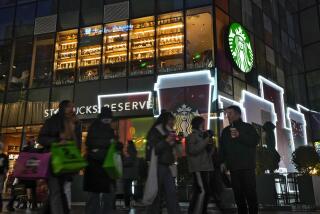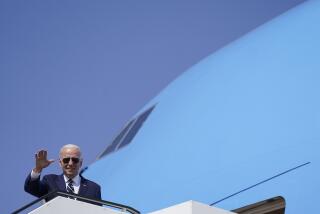Asia Beckons as Land of Vast Opportunity
- Share via
One of the ironies of this time is that the world’s largest market is emerging in Asia and yet much of U.S. business has its gaze riveted on Europe, speculating about 1992 when the 12 Common Market countries unite their economies, or on the changing economies of Eastern Europe.
But the story is more historic and the market more exciting in Asia and the Pacific, where Japan and a dozen other countries are now becoming a self-sufficient trading area that is larger than Europe today and could surpass North America as well by the end of this decade.
The Asia Pacific region, as this market calls itself, is 500 million people spread over a vast area from Japan and Korea in the north to Malaysia and Indonesia. Australia and New Zealand are included in it, and Vietnam, Laos, Cambodia and the coastal provinces of China will join it, say experts.
Basically, Asia Pacific includes the countries that have developed over the last two decades by making goods for export to the United States, which last year imported more from Asia--outside of Japan--than it bought from Europe.
But now those countries are beginning to rely more on trade among themselves and with Japan than on trans-Pacific trade with the United States. And within two years such “intra-Asian” trade will reach $300 billion and surpass Asia’s trade with the United States.
What does that mean for U.S. business? A glorious opportunity or the threat of being left behind in a changing world.
It’s important to understand the transformation Asia is going through.
“What is going on is more than a doubling of rice bowls--an expanded market of poor people,” George Baeder, a Hong Kong-based consultant, explained this week to a San Francisco conference on the Asia Pacific region. “Within this decade Asia will pass Europe as a telecommunications market--and still be in its infancy. It will soon pass Europe and North America as a market for paint and steel--and by the year 2000, Asia outside of Japan will be producing 40% of the world’s cars.”
You get an idea of what’s happening if you consider that Malaysia, a nation of 14 million that used to be rubber supplier to the British Empire, is now one of the world’s largest producers of semiconductors. Its neighbor Singapore, once a key port of the Empire, is a high-tech supplier to Sony, General Electric and Western Digital.
How did the people of the Malay Peninsula make such progress? By educating the work force (Malaysia has 90% literacy, Singapore 100%), attracting foreign investment from the United States and Japan, and manufacturing for export.
By stressing education, said Singapore’s Prime Minister Lee Kuan Yew, Asian nations such as his had given the world a new model for development: Poor nations can become rich within a couple of generations.
When Lee says rich, he is speaking relatively. Singapore’s skilled workers make $400 a month, while low-skill work is done in Indonesia at one-fourth of that cost. But the work is there these days as Japan and Korea, having gone on to much higher wages, hand off lower skilled work to Malaysia, Indonesia, Thailand and others.
And even $100 a week makes big changes when it’s the first cash wages ever earned. Family patterns change, young people no longer live with their elders, women go out to work, and refrigerators and supermarkets become facts of urban life.
That’s where opportunity comes in, says Fortune magazine in a special issue on Asia. In this decade, more than 100 million Asian households outside of Japan will attain middle-class incomes and consumer tastes.
But the response of U.S. companies to that opportunity is spotty. So far U.S. business has invested only $40.2 billion in Asia--including Japan--compared to $176.7 billion in Europe.
In some cases, U.S. industry goes on paying for past lack of initiative. In televisions and VCRs, no U.S. products will grace Asia’s new living rooms because U.S. companies quit that business decades ago, explaining that the business had ceased to grow.
Also, U.S. auto makers are weak in Asia (aside from some cash investments in Korea and Japan). So unlike Europe, where Ford and General Motors lead many markets, the cars of Asia will be Toyotas and Hondas.
Some U.S. companies are awake. Toys R Us is opening in Japan; McDonald’s, long a fixture in Japan, is expanding in Korea. Pepsico is everywhere, even the back roads of Laos.
But whole segments of U.S. industry lack vision. No U.S. supermarket chain has gone to Asia, for example. So the Hong Kong-based Dairy Farm chain, and a Japanese company named Jusco, are winning all the new supermarket customers in Thailand and Malaysia.
What were the U.S. chains doing? Well, Safeway did a leveraged buyout, other chains did mergers--explaining that the supermarket business had ceased to grow.
The challenge of the time is very clear: “In the next 40 years,” says Singapore’s Lee Kuan Yew, “the world’s center of gravity will shift to the Pacific.”
And either U.S. business shifts with it, or its importance in the world will fade, as has the power of the colonial empires that still ruled Asia only 40 years ago.
More to Read
Inside the business of entertainment
The Wide Shot brings you news, analysis and insights on everything from streaming wars to production — and what it all means for the future.
You may occasionally receive promotional content from the Los Angeles Times.










